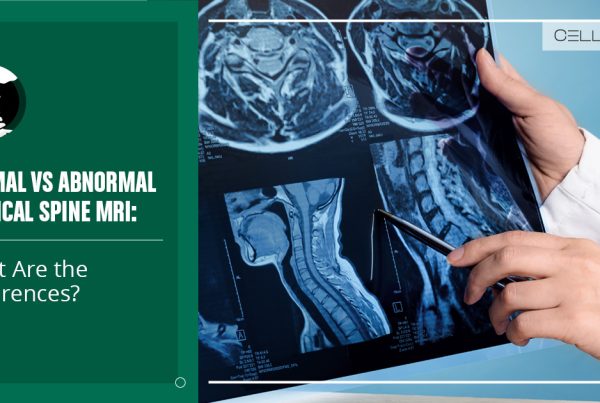Published on: December 5, 2024 | Updated on: January 18, 2025
A spinal hemangioma is a noncancerous (benign) tumor that grows on the backbone. It is the most common tumor of the spine. This tumor does not cause any symptoms. Therefore, it is an asymptomatic tumor.
In rare cases, hemangiomas of the spine cause backache and numbness. A spinal hemangioma is made up of the blood vessels.
In most cases, it is diagnosed alongside some spinal issue that requires an imaging test. What causes hemangiomas of the spine? Does it have risk factors? Let’s discover more about this spinal growth.
What Are Spinal Hemangiomas?
About 33 bony structures called the vertebrae make up our spine. A spinal hemangioma is a noncancerous growth that appears as a red or purple lump on the skin, commonly in the lumbar region. The cells of the blood vessels, also called endothelial cells, form spinal hemangiomas.
This common spinal tumor does not present symptoms, due to which individuals with hemangiomas don’t require treatment.
In rare cases, the rapid division of endothelial cells forms a huge lump. This lump puts pressure on the surrounding structures, causing neurological problems and spine compression.
What Causes Hemangiomas of the Spine?
Hemangiomas are idiopathic—meaning their cause is unidentified. While the primary cause remains unclear, certain factors, such as genetics and hormones, may play a key role in causing hemangiomas of the spine.
Genetic Causes
Genetic factors play a role in the development of hemangiomas of the spine because vascular malformation is an autosomal dominant trait.
Autosomal dominant traits are expressed when one gene is necessary for the condition. This gene passes from the parent to the child with a 50/50 risk.
In autosomal dominant inheritance, one copy of the altered gene is inherited by the child. If spinal hemangiomas are linked to one such gene, an affected parent can pass off the gene to a child, predisposing them to develop spinal hemangioma.
Abnormal Vascular Growth
Since hemangiomas of the spine are vascular malformations, genetic growth factors such as gene variation and mutations could be held responsible to some extent. New blood vessels form by a process called angiogenesis.
Genetic factors such as mutations or variations in genes that regulate the vascular development process cause disorganized vessel growth in the spinal column, which forms hemangiomas of the spine.
Besides this, any problem during the development of the spine could cause hemangiomas that remain asymptomatic until adulthood.
Hormonal Influences
Hemangiomas are more common in females, which suggests hormonal influence. According to studies, the hormone estrogen contributes to hemangioma’s growth.
This also explains the occurrence of hemangiomas during pregnancy or the enlargement of preexisting vascular growths.
During pregnancy, hormone levels change, including estrogen, which impacts the formation and enlargement of hemangiomas.
Local Mechanical Factors
The lumbar spine refers to the lower back with the five largest vertebrae. The lower back receives most of the mechanical stress as it bears the body weight.
While mechanical factors don’t directly cause hemangiomas, the repetitive stress on the spine could contribute to symptoms of hemangiomas. In most cases, hemangiomas don’t present any symptoms or complications.
In adulthood, bearing significant weight on the spine, which is a common region for hemangiomas, causes pain.
Age-Related Changes
While there is ongoing research about what causes hemangiomas of the spine, some studies conclude that age-related changes could be a cause. Spinal hemangiomas are more common in women over the age of 40.
With age, degenerative conditions such as degenerative disc disease impair the blood flow to the vertebral structures. Altered blood flow affects vascular growth in the spine, causing hemangiomas. These changes may also result in the enlargement of existing hemangiomas.
Risk Factors for Spinal Hemangiomas
While benign, noncancerous hemangiomas present no symptoms, the symptomatic hemangiomas make up 1% of all hemangiomas. If left untreated, they can cause neurological issues. Risk factors include the following.
- Age: High prevalence in people aged 40 and above
- Gender: More common in women
- Family history: Genetics play a role in vascular malformations
- Medical history: Other vascular malformations put you at an increased risk for hemangiomas
Most of these risk factors are not modifiable. Since 1% of symptomatic spinal hemangioma occurs, it’s important to recognize the symptoms for prompt treatment.
Symptoms of Hemangiomas of the Spine
Symptoms of spinal hemangiomas include:
- Back pain
- Numbness
- Nerve compression
- Radicular pain
- Bowel and bladder dysfunction
- A tingling sensation in the lower back
Complications of a Spinal Hemangioma
What causes hemangiomas of the spine is often related to the diverse complications it presents. For example, most genetic factors at play do not cause complications such as bone fractures.
However, if vascular malformations enlarge the hemangiomas, they affect the spine and cause complications.
Some painful complications include:
- Bone displacement
- Spinal canal erosion
- Bone fractures
- Hematoma
- Nerve compression
- Severe lower back pain
- Restricted movement
Treatment for Spinal Hemangiomas
The treatment methods for hemangiomas of the spine depend on how severe the symptoms are. Some factors influence the treatment options. These include the size of the hemangioma, its location, and whether it is symptomatic or asymptomatic.
Radiation Therapy
The most common line of treatment for the hemangiomas of the spine is radiation therapy. If the hemangiomas cause neurological symptoms, the radiation is targeted to the growth to shrink it.
Reducing the size of the hemangiomas relieves pressure on the surrounding structures, such as nerves, vertebrae, and muscles. This is a non-invasive method that works well in cases where surgery poses risks.
Endovascular Embolization
Endovascular embolization of the spinal hemangioma refers to a process that blocks the blood flow to the tumor.
A catheter injects materials into the blood vessels that supply the tumor. Once the blood supply is cut off, the hemangioma shrinks.
Surgery
Large hemangiomas of the spine push against the adjacent structures, causing pain. They also compress the nerves and lead to spinal instability. In such cases, surgical intervention is needed to completely remove the hemangioma.
Vertebrectomy is a type of surgery that removes the affected vertebra. The risks of surgery include excessive bleeding, artery damage, blood clotting, and infection. Therefore, surgical intervention is reserved for rare cases where other treatments prove ineffective.
Final Words
There isn’t a definite way to prevent hemangioma, as the known causes are unmodifiable. Most cases of hemangiomas of the spine remain asymptomatic.
They only get diagnosed as a result of screening for some unrelated reason. Therefore, hemangioma is not a threat to your well-being.
However, if you notice back pain, a lump in your spine, or other associated problems, consult a doctor for diagnosis and treatment. The advanced treatment options can effectively address symptomatic and asymptomatic hemangioma of the spine.
Sources
Footnotes
- Patel S, Ansari D, Patil SN, Burch TG, Chaker AN, Rosinski CL, Chaudhry NS, Mehta AI. High-Grade Spinal Hemangioma: A National Cancer Database Analysis. World Neurosurg. 2021 Apr;148.
- Jain N, Tadghare J, Patel A, Varma A. Vertebral Hemangioma an Extremely Rare Cause of Spinal Cord Compression in Children: A Case Report. J Pediatr Neurosci. 2018 Oct-Dec;13(4):483-485.
- Materna-Kiryluk A, Wiśniewska K, Więckowska B, Wróblewska-Seniuk K, Jaroszewska-Świątek B, Helwich E, Latos-Bieleńska A. Genetic and Environmental Risk Factors for Isolated Hemangiomas in Infants. Children (Basel). 2020 Oct;7(10):150.
- Castrén E, Salminen P, Vikkula M, Pitkäranta A, Klockars T. Inheritance Patterns of Infantile Hemangioma. Pediatrics. 2016 Nov;138(5)
- Abul-Kasim K, Persson E, Ohlin A. Vertebral Hemangiomas: Prevalence, New Classification, and Natural History. Magnetic Resonance Imaging-Based Retrospective Longitudinal Study. J Orthop Traumatol. 2022;36(1).
- Okamoto A, Nakagawa I, Matsuda R, Nishimura F, Motoyama Y, Park YS, Nakamura M, Nakase H. Intracranial Capillary Hemangioma in an Elderly Patient. Surg Neurol Int. 2015;6(21).
- Aksu G, Korcum A. Radiotherapy in Vertebral Hemangioma. Int J Radiat Oncol Biol Phys. 2005;63(1).
- Boyd VC, Bui D, Naik B, Levy ML, Hicks MJ, Hollier L Jr. Surgery: The Treatment of Choice for Hemangiomas. Semin Plast Surg. 2006 Aug;20(3):163-168.
- Feuerman T, Dwan PS, Young RF. Vertebrectomy for Treatment of Vertebral Hemangioma Without Preoperative Embolization. Case Report. J Neurosurg. 1986 Sep;65(3):404-406.
References
- What Is Angiogenesis? Cleveland Clinic. Accessed 09/17/2024.
- Lumbar Spine. Cleveland Clinic. Accessed 09/17/2024.
- Degenerative Disk Disease. Cleveland Clinic. Accessed 09/17/2024.
- Endovascular Embolization. MedlinePlus. Accessed 09/17/2024.
CELLAXYS does not offer Stem Cell Therapy as a cure for any medical condition. No statements or treatments presented by Cellaxys have been evaluated or approved by the Food and Drug Administration (FDA). This site contains no medical advice. All statements and opinions are provided for educational and informational purposes only.
Dr Pejman Bady
Author
Dr. Pejman Bady began his career over 20 years ago in Family/Emergency Medicine, working in fast-paced emergency departments in Nevada and Kansas. He has served the people of Las Vegas as a physician for over two decades. Throughout this time, he has been met with much acclaim and is now the head of Emergency Medical Services in Nye County, Nevada. More about the doctor on this page.
Dr Pouya Mohajer
Contributor
Pouya Mohajer, M.D. is the Director of Spine and Interventional Medicine for CELLAXYS: Age, Regenerative, and Interventional Medicine Centers. He has over 20 years of experience in pain management, perioperative medicine, and anesthesiology. Dr. Mohajer founded and is the Medical Director of Southern Nevada Pain Specialists and PRIMMED Clinics. He has dedicated his career to surgical innovation and scientific advancement. More about the doctor on this page.









